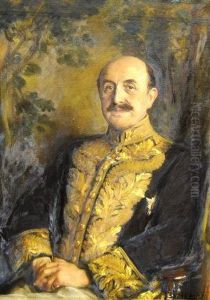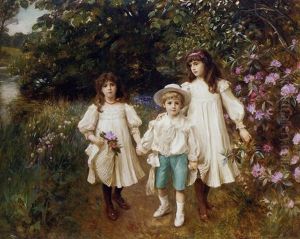George Harcourt Paintings
George Harcourt was a distinguished British portrait painter whose artistry flourished in the late 19th and early 20th centuries. Born on September 1, 1868, in St. Pancras, London, Harcourt came from a background that was not particularly noted for artistic endeavors. However, his passion and talent for painting emerged early on, leading him to pursue a career that would eventually earn him significant acclaim in the realm of portrait art.
Harcourt's education in art was both rigorous and extensive. He studied at the prestigious Royal Academy Schools, a foundational experience that honed his skills and deepened his appreciation for classical artistry. His style, predominantly traditional, was influenced by the grand manner of historical portraiture, yet he infused his work with a sensitivity and insight that captured the personality and essence of his subjects. This ability to portray not just the likeness but the character of the individual set Harcourt apart from many of his contemporaries.
Throughout his career, George Harcourt was renowned for his portraits of the British aristocracy and notable figures of his time. His work was regularly exhibited at the Royal Academy from 1889, marking the beginning of a long and fruitful association with the institution. Harcourt's portraits were praised for their elegance, refinement, and the meticulous attention to detail, qualities that made him a favorite among high society.
In recognition of his contribution to British art and his mastery of portrait painting, Harcourt was elected as an Associate of the Royal Academy (ARA) in 1919 and subsequently became a full Royal Academician (RA) in 1928. These accolades reflected not only his artistic achievements but also the high regard in which he was held by his peers.
George Harcourt's legacy is not merely in the portraits that hang in galleries and private collections but also in the influence he had on portrait painting as a genre. His adherence to classical techniques, coupled with a deeply personal approach to capturing his subjects, offers a bridge between the traditional and the modern. Harcourt passed away on October 1, 1947, leaving behind a body of work that continues to be celebrated for its craftsmanship and emotional depth. His paintings offer a glimpse into the lives and personalities of his era's figures, encapsulating the spirit of his time in a way that few artists could.










